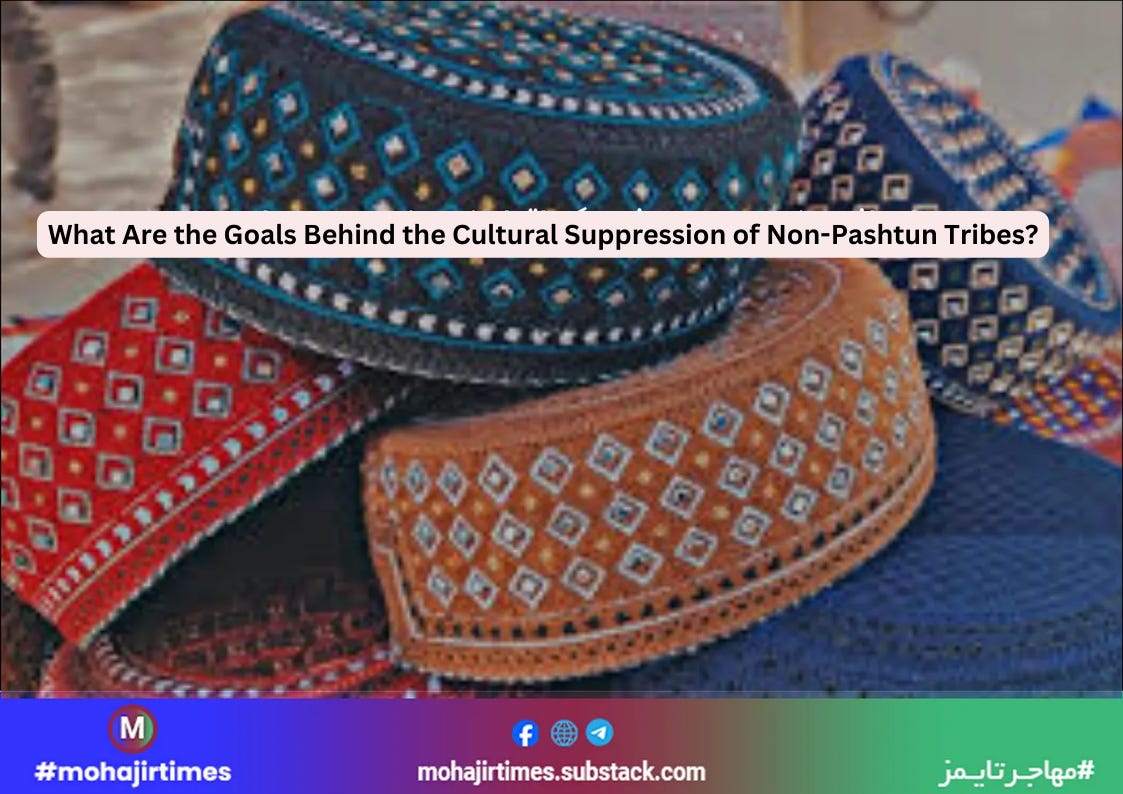What Are the Goals Behind the Cultural Suppression of Non-Pashtun Tribes?
By Mohajir Times
Starting tomorrow, August 15, 2021, the Kandahari hat became a fashion market in Afghanistan. Not only the Pashtuns but also other ethnic groups gave up in this fashion in a humiliating manner. Kandahari hat is one of the manifestations and symbols of Pashtun tribal culture in Afghanistan. But in the cultural identity of other ethnic groups, such as Hazaras, Tajiks, and Uzbeks, there is no such cultural symbol. Afghanistan is a multi-cultural and multi-ethnic country where each nation has its own local and indigenous culture. These cultures may have similarities and commonalities in general, but they differ in specific ways. We have Hazaragi culture, as well as Tajik, Uzbek, Pamiri and Nuristani. But when the Kandahari hat makes a place in the cultural life of other ethnic groups, what are the consequences ahead?
The return of the Taliban group has been associated with unrestrained socio-political, ethnic, gender, religious, and cultural suppression and oppression and has plunged the Afghanistan society into public fear. This fear casts a shadow, especially on the social life of non-Pashtun ethnic groups. In this gloomy situation, the masses of people were looking for a mask to hide their anti-Taliban face behind. Beards became fashionable, and faces became shaggy. Shirt embroidery shops flourished, and suits fell out of fashion. The Kandahari hat made the bazaar a success. The situation of the non-Pashtun people, especially the Hazaras, in such a gloomy situation is spectacular and cinematic. We see many marketers, workers, artisans, business people, drivers, Hazara youth, and teenagers wearing Kandahari hats every daylight.
Giving in to the Taliban tribal-religious culture, whether it is out of consent or out of necessity, fear, and coercion, helps to develop this culture as a dominant culture. This dominant culture can be a tool for the continuation of the Taliban's political dominance. The continuation of the Taliban's political domination means the cultural-political suppression of other ethnic groups! Therefore, the non-Pashtun ethnic groups resort to the Kandahari hat due to enthusiasm and the color of the cultural-political atmosphere of becoming the ruler or using other symbols of the Pashtun tribal culture. On the one hand, they unknowingly help to establish the rule of the Taliban tribal-religious culture. On the other hand, they oppress, humiliate, and trample on their local and native cultures.
Taliban seeks to build and normalize homogenous tribal-religious culture as the dominant culture. A dominant homogenous tribal-religious culture that marginalizes and suppresses other cultures. The Taliban's enmity with the Persian language and the suppression of the Shia religion also originates from this goal. Religion (Hanafi religion) is the best tool that helps the Taliban to establish tribal-religious cultural domination. We recognize Afghanistan as a multi-cultural, multi-ethnic, and multi-national country. A country that does not have a homogenous culture. The dominance of tribal-religious culture, which the Taliban and its operatives practice, harms the diversity and cultural rainbow of Afghanistan. Perhaps they have the intention of eradicating and destroying other cultures.
As the dominant culture, the tribal-religious culture of Talibanism creates reactions. One of the significant reactions is to turn to identity politics, which is reflected in the political currents and thoughts of non-Pashtun ethnic groups. It is also evident that identity politics turns Afghanistan into a battlefield of identities. It is better to say that Afghanistan has turned into a battlefield of identities since years ago. The reason can be found in the dominance of Pashtunism nationalism. The Jihadi parties were generally identity parties. Pashtuns, Tajiks, Hazaras, and Uzbeks had their own ethnic-religious or identity parties. Thus, identity politics can be clearly understood in the light of the twenty-year experience of the fake republic. Ethnic coalitions in the presidential elections were a clear expression of identity politics.
Why have the coalitions of ethnic political parties not been stable in the last twenty years? Identity politics thinks about its own political and identity interests and ignores other identities. The reason for the instability of ethnic coalitions in the past twenty years, in the era of the fake republic, lies in these identity politics. Pashtun nationalism thinks about its own political and identity interests. Sometimes, their hegemonic interests required them to seek an alliance with one or more parties and political currents from non-Pashtun ethnic groups.
In the same way, political parties and currents of Tajik, Hazara, and Uzbek peoples resorted to coalition with each other. The most important consequence of this identity policy was stifling national sentiments. If we search for the reasons for the lack of national feelings in the last twenty years, identity politics is one of the main reasons.
Now, the Taliban have decided to destroy other cultural identities by applying their tribal-religious culture as the dominant culture. Pashtun nationalism, which is now hidden behind the religious mask of the Taliban, binds the non-Pashtun ethnic-cultural identities by bullying. What policy will the non-Pashtun tribes plan against such a policy? Will they continue to engage in identity politics like in the past and cling to unstable coalitions? Do Tajiks see Hazaras and Uzbeks as an allied descent group, and do Hazaras and Uzbeks see Tajiks? Will there be a way for the national identity of citizenship and the awakening of national feeling in Afghanistan?
*Rafiq Ibrahim is the pen name of a freelance writer and a social activist
Related issues:






